The Dominican Republic has an array of stunning caves, many with fascinating histories and breathtaking geological formations. Some are located within national parks, with cave art left by the indigenous Taíno people, while others are set in lush jungles or along coastlines. Here are the 10 best caves you might want to explore while visiting the Dominican Republic, some of them reachable with a guided tour from Punta Cana:
1. Los Tres Ojos National Park (AVAILABLE TO VISIT FROM PUNTA CANA)
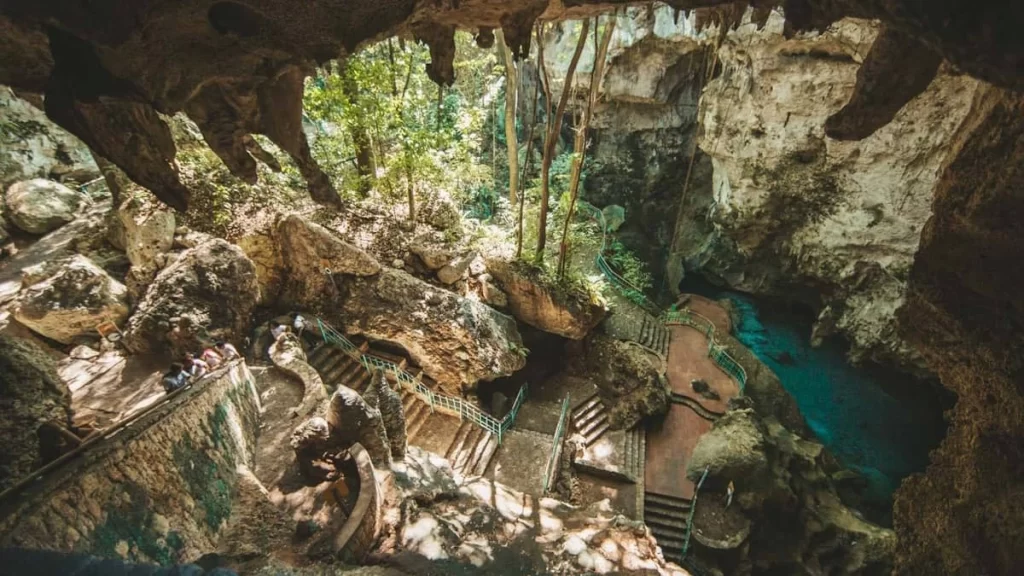
Just eight kilometers east of Santo Domingo, the Three Eyes National Park (Los Tres Ojos) is a beautiful natural respite near the city, where you can observe the Taino underground caverns that were once used as a refuge or ritual site. A staircase leads to a series of caves, with paths that embrace three iridescent blue freshwater lagoons, or “eyes” as the Taino used to call them for their oval shapes. A fourth lagoon is accessible via a small wooden barge, revealing a magnificent open-air landscape with rock formations covered in lush vegetation. Keep an eye out for petroglyphs and handmade ceramic items.
Initially it was a single lake, but after a portion of the cave, formed by limestone, collapsed, it was divided into three:
- Lago de Aguas Azufradas: with about four meters of its depth, you will see a white color at the bottom. Initially it was thought to be sulfur, hence its name, but it was discovered that it was calcium and other minerals that give the bottom its particular color.
- La Nevera: It is the second deepest lake, just over 5 meters deep and, as its name indicates, it is the coldest, with temperatures between 15 and 21 degrees. The sunlight does not reach here.
- Lago de las Damas: It is the shallowest, although it is located in the deepest area. Its name is due to the fact that it was previously a lake intended for women and children.
Currently, Los Tres Ojos has a fourth freshwater lake, turquoise in color, named “Zaramagullones” and can only be accessed on board a small boat. Just over 6 meters deep, the lake is bordered by rock formations and lush vegetation. It is the only lake that is outdoors.
If you are in Punta Cana you can visit this place by taking our Day Trip to Santo Domingo available through Expedia. Or if you wanna save some money you can book directly from our website and save 20% using our promo code LPCTOURS.
2. Cueva de las Maravillas (Caves of Wonders) (AVAILABLE TO VISIT FROM PUNTA CANA)
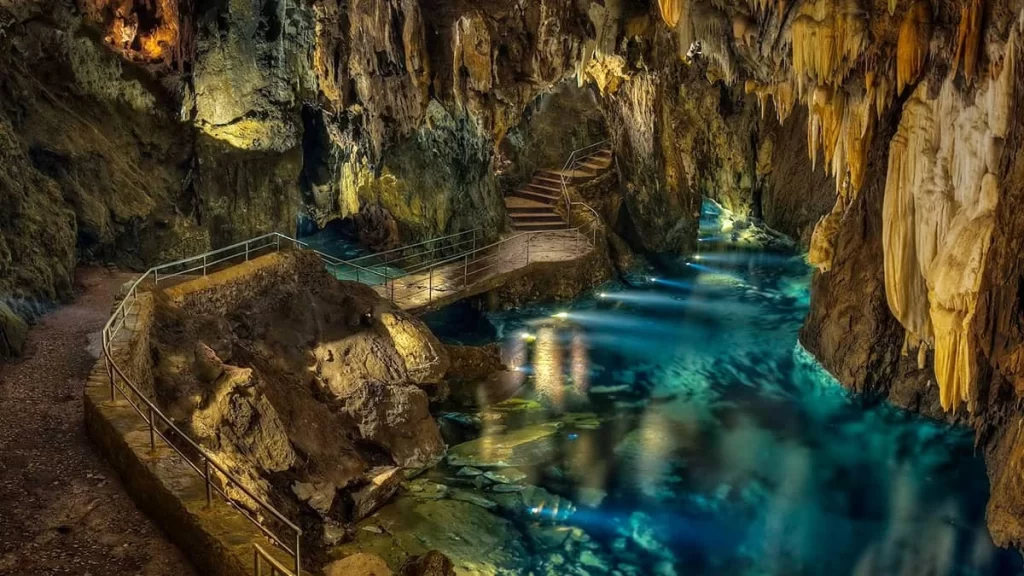
The Cave of Wonders National Park is a protected area in the eastern part of the Dominican Republic. The Cave of Wonders (until 1949 called Jagual Cave) is known for its ancient paintings made by the Taino aborigines.
It is located in the province of San Pedro de Macoris, on the road from this city to La Romana, near the Soco and Cumayasa Rivers. It is 800 meters long and located 25 meters underground. It has an area of 4.5 square kilometers and was declared a national park on July 22, 1997.
Inside the cave you can see around 500 paintings on the walls and engravings where black and red predominate, made by the Tainos, ancient inhabitants of the island who are now extinct. According to information, it has 10 petroglyphs, that is, engravings on the rock, and 472 pictographs, that is, paintings on the walls.
The attractions offered by the wonderful cave are: the Pictographic Gallery, The Mirror of Water, which consists of an artificial lake that reflects the upper part of the cave like a mirror and The Great Panel, in the latter you can see a cave painting created by the Tainos, which represents a funeral ritual, among others.
Tips for visiting the Caves of Wonders
- Adequate lighting: The interior of the cave is dark, so it is important to follow the guide’s instructions and not use flash on cameras to avoid damaging the cave paintings. The guides provide adequate lighting for the visit.
- Comfortable clothing and footwear: It is advisable to wear light, comfortable clothing, as well as footwear suitable for walking on rocky and wet terrain, as the ground can be slippery in some areas of the caves.
- Sun protection and insect repellent: When walking along the park’s trails, it is a good idea to bring sunscreen and repellent, as the area has tropical vegetation.
- Respect the place: It is essential to follow the guides’ instructions and respect the natural and cultural environment of the site. The cave paintings are fragile and must be protected.
How to get to the Caves of Wonders
From Santo Domingo: You can take the Higüey Highway towards the province of La Romana, and then follow the signs that indicate the park. The estimated travel time is about 2 hours by car.
From Bavaro or Punta Cana: The caves are located approximately 30-40 minutes by car from the main resorts in the Bavaro and Punta Cana area, making them a popular excursion for tourists staying in the region.
Hours
Generally, the Caves of Wonders are open every day of the week. Visiting hours are usually from 9:00 a.m. to 4:00 p.m., although this can vary depending on the season and weather conditions.
You can visit this cave booking our full day tour Caves of Wonders Tour with Cigar Factory and Altos de Chavón. The same tour is also available on Viator here.
3. Fun Fun Cave (Cueva Fun Fun)
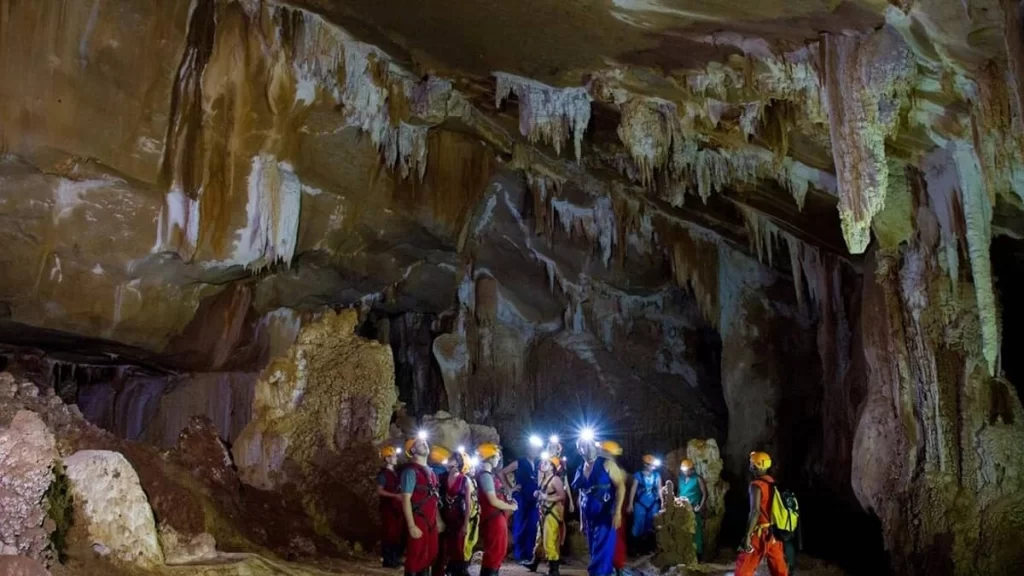
Fun Fun Cave is one of the most impressive natural wonders of the Dominican Republic, located in the province of Hato Mayor, in the eastern region of the country. This cave is famous for its size, its geological beauty, and the adventure activities it offers to tourists looking for an experience.
To reach the entrance of the cave, you must take a walk of approximately 20-30 minutes from the meeting point in the Sabana de la Mar area. The trail goes through the rainforest and is a moderately difficult walk. In some sections, it is necessary to cross streams and rocky paths, which makes access a real adventure.
It has more than 2 kilometers of underground tunnels. It is known for its impressive system of caverns, which includes stalactites and stalagmites of different shapes and sizes, creating a spectacular underground landscape. The interior of the cave is dark and mysterious, with areas that include pools of water and unique rock formations.
In addition to exploring the cave, tourists can enjoy a variety of activities, such as:
- Rappelling: One of the most exciting activities is rappelling (descending rock walls) in some of the formations inside the cave.
- Bathing in the pools: Inside the cave, there are some pools of crystal-clear water where tourists can take a refreshing bath.
- Fauna and flora: In the surroundings of the cave and at its entrance, you can enjoy the rich biodiversity of the area, with tropical flora and local fauna, such as birds, insects and reptiles.
- Ecological and adventure tourism: Although the cave is relatively accessible, it is recommended to hire a specialized local guide to safely tour it and learn about the history and geology of the place. It is also important to remember that the cave is located in a protected area, so ecological regulations must be respected to preserve its beauty.
Tips for visiting Fun Fun Cave:
- Physical preparation: The hike to the cave is not difficult, but it can be demanding in some sections, especially if there is previous rain that makes the terrain slippery. It is advisable to be in moderate physical condition.
- Equipment: Bring appropriate clothing and footwear for hiking, preferably boots or waterproof shoes, as some areas of the cave may be wet. It is also important to bring sunscreen, insect repellent, and a flashlight (if not provided by the guides).
- Local guides: It is highly recommended to hire a local guide for the full experience. The guides not only know the terrain, but also provide valuable information about the history, geology, and flora and fauna of the park.
How to get there
From Santo Domingo, you can reach Sabana de la Mar by car, via the Higüey-Sabana de la Mar Highway, which takes about 2-3 hours. Once there, you can arrange a tour to the cave with local guides who are in the area.
Fun Fun Cave is an impressive destination that combines adventure, nature and a unique experience in the Dominican Republic. It is perfect for those looking for something different from the typical beaches and want to explore the natural beauty of the country in a more active and exciting way.
4. Cueva de la Línea (Los Haitises National Park) (AVAILABLE TO VISIT FROM PUNTA CANA)
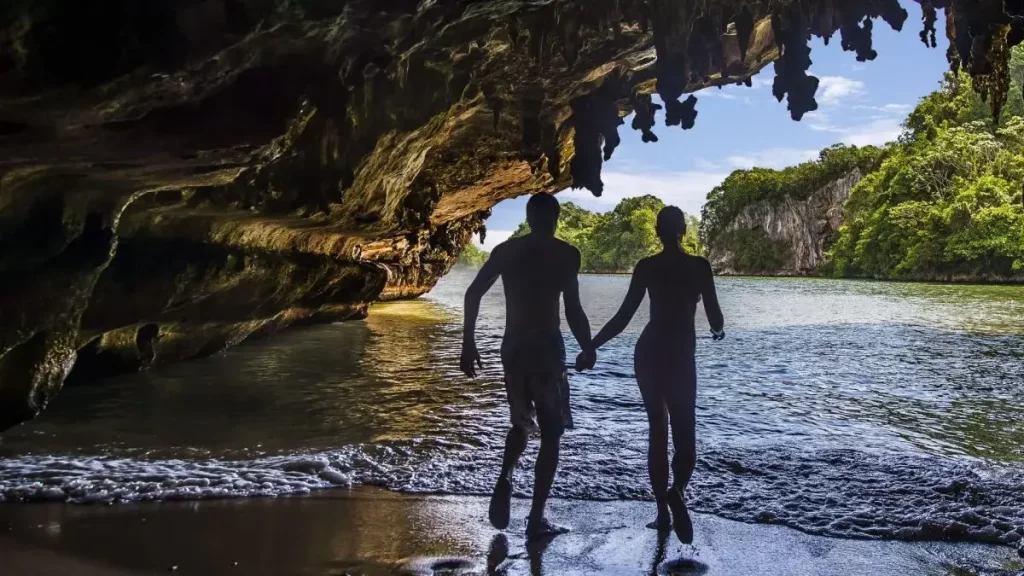
This cave is the most important inside the Natural Park of Los Haitises in relation to the rock art it contains. It is located in the Caño Preso area, on the edge of an extensive mangrove swamp. The name of Cueva de la Línea (or del Ferrocarril) comes from the existence of an old railway line in its surroundings that was used to take the rice production in the area to a dock. The cave is about 600 meters long and sunlight can be seen throughout the entire length.
It is also known as “the Temple Cave” because it looks like an altar due to the hundreds of pictograms and petroglyphs on its walls.
There are still more than 950 paintings on its walls despite the passage of time, but there are also some of them that, as can be seen, have disappeared, so it is believed that the cave could have had many more paintings. Cueva de la Línea features characteristic rock formations, such as stalactites and stalagmites, formed over thousands of years. These geological formations contribute to the unique atmosphere inside the cave.
Access: Getting to Cueva de la Línea is not that simple, as it is located in a remote area within Los Haitises National Park. To access the cave, tourists must take a boat tour of San Lorenzo Bay and then walk to the entrance of the cave, which is located in a jungle and mountainous environment. The boat tour offers spectacular views of the Los Haitises coast, while the hike to the cave is done along trails surrounded by nature.
Eco and cultural tourism: Cueva de la Línea is an excellent option for those looking for eco and cultural tourism. In addition to exploring the cave, visitors can enjoy the beautiful landscape of Los Haitises, which includes mangroves, bays, and a rich biodiversity of flora and fauna. You can also hike through the park, visiting other caves and rock formations in the area.
Guided tour: Since access to the cave can be complicated, it is best to visit the site with a specialized guide who knows the area and can offer a complete experience. Local guides will not only help you get to the site, but will also explain the history and particularities of the cave and the park.
Tips for visiting Cueva de la Línea:
- Appropriate clothing: Wear comfortable clothing and shoes suitable for walking on rocky and wet terrain. Hiking boots or water-resistant shoes are highly recommended.
- Sunscreen and repellent: As part of the tour is outdoors, be sure to bring sunscreen, insect repellent, and a bottle of water.
- Flashlight: The cave can be quite dark in some areas, so it is advisable to bring a flashlight or headlamp to be able to properly explore the interior.
- Respect conservation rules: Being an archaeological site, it is essential not to touch the cave paintings or alter the natural environment of the place.
How to get to Cueva de la Línea
From Santo Domingo: You can take a bus or private vehicle to Sabana de la Mar, which is about a 2-3 hour drive from Santo Domingo. From there, you take a boat tour that takes visitors to the entrance of the park or the cave.
Boat: Access to the cave is mainly by boat, allowing you to enjoy the coastal landscape of Los Haitises.
Cueva de la Línea is an ideal destination for those interested in Taino history, geology, and nature. It offers a unique experience of cultural tourism and ecotourism in a stunning natural setting. If you have the opportunity to visit it, it will be an excellent way to explore one of the archaeological and natural wonders of the Dominican Republic.
If you are in Punta Cana, you can visit it by taking our Full-Day Eco Tour in Los Haitises with Montana Redonda and Yanigua Spa or the other option with the beautiful Paraiso Cano Hondo. On Viator this is one of our most popular tours!
5. Cabarete Caves
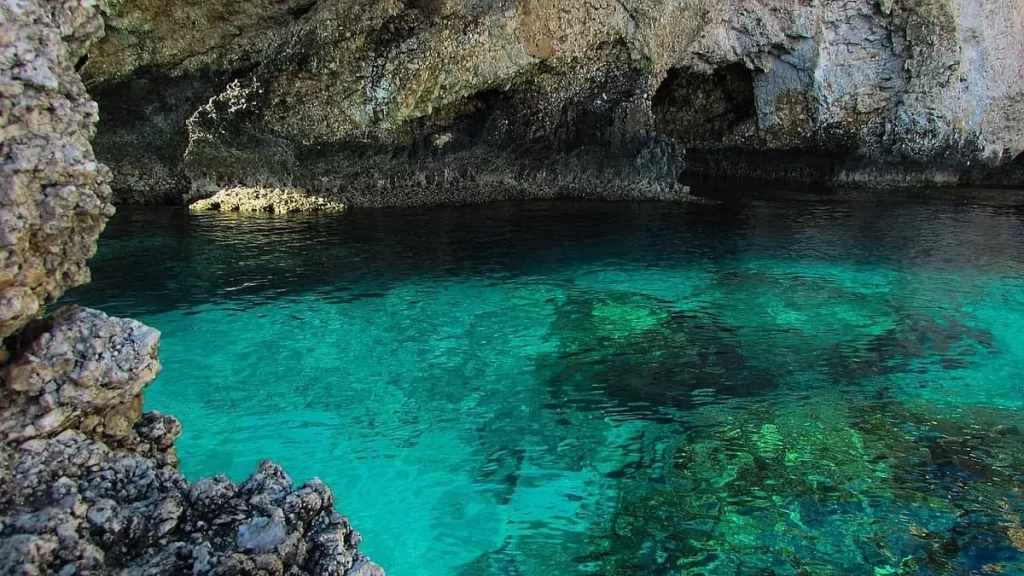
Located in El Choco National Park, the Cabarete Caves are a playground for outdoor enthusiasts. This network of caves dates back millions of years. Exploring the caves is a popular day trip for recent visitors; many called the caves a hidden gem and raved about the experience.
Visitors can opt for an organized tour that departs from Cabarete or hire knowledgeable bilingual guides at the park, who can take participants to explore the various chambers.
On a tour, travelers can hike, swim, and admire the cave’s stalactites, stalagmites, and rock art. El Choco is located less than 15 minutes from Cabarete. There are two main entrances, but the closest to town is the east side entrance, about a 15-minute walk from the town center.
This attraction offers its visitors a variety of ecotourism experiences that lead through trails that lead to an encounter with four caves (Vudú, Piscina, Cristal and la de la Rana). These cavities connect with underground water systems, suitable for diving or submerging in a refreshing bath, within a cave environment, with thousands of stalactites and stalagmites.
There are several dry caves that have shallow pools suitable for swimming and are safe for families and children. Local companies offer sustainable tours of the El Choco National Park with bike rides, hikes and boat rides, respecting the natural resources of the area, which is a reference for ecotourism in the province of Puerto Plata.
6. Bridge Cave (Cueva del Puente)
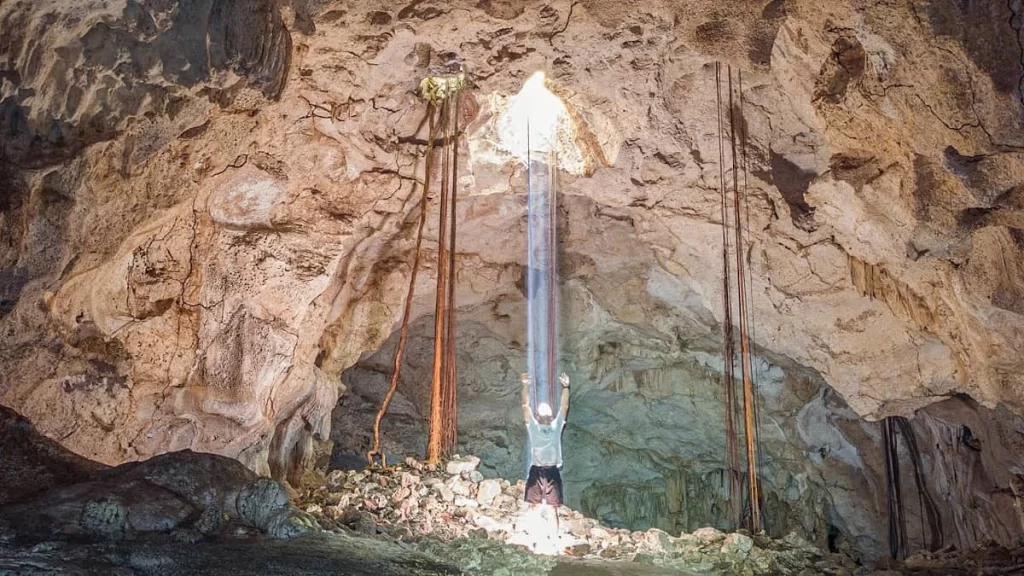
Bridge Cave is one of the most accessible caves in Cotubanamá National Park, which has more than 400. Bridge Cave features a three-level chamber with stalactites, stalagmites, Taino pictographs and numerous bats.
The cave trail is located approximately three kilometers south of the park entrance and takes about 30 minutes to reach through a tropical forest full of birds and lizards. The gigantic caverns have dark parts, while in certain sections there are holes that let in daylight.
Just 6 km from Dominicus, in Guaranao, once the fee has been paid, a guide will show us the way on a walk of about half an hour to the interesting cave. Once inside, it will be necessary to use a flashlight to appreciate the dozens of Taino pictographs and petroglyphs. Come and discover a unique place, see the dry subtropical forest of the Caribbean coast, observe the flora and fauna of this unique ecosystem, with such peculiar trees as the alpargata, the gringo or the Bayahibe flower, which is the national flower.
The visit is free access (after paying the entrance fee to the park, which is 100 pesos). The caves are large, easy to move around and there are stalactites, stalagmites and typical cave animals such as bats.
7. Chicho Cave

Chicho Cave is a spring located underground, which is one of the most impressive places in the entire Dominican Republic.
Its natural pool of crystal-clear water is formed under stalactites and stalagmites that have been forming over the course of millions of years. This is why this place has a geological importance that is worth knowing, since these cenotes located kilometers away from the coast are very interesting and strange.
Chicho Cave is located northwest of the Cotubanamá National Park, very close to the town of Bayahibe. To get there from Punta Cana or any other point on the island, we recommend you do so by private transport.
Once you arrive in Bayahibe, you can take the 45-minute walk to Chicho Cave along a perfectly marked path on your own. There is also the option of hiring a guide who will explain everything you need to know about the history and nature of this place, which is highly recommended.
One of the most popular activities in Cueva de Chicho is diving. The good visibility underwater means that we can swim and snorkel in this beautiful place. Unlike other cenotes, here we find a freshwater lake, which comes from the water that collects above the caves and is filtered until it is full.
For those who love scuba diving, they should know that it is also possible to go scuba diving in Cueva de Chicho. The most interesting thing is that the natural pool is connected to another one that must be accessed by going underwater, an activity that is highly recommended if you want to get to know this magical place in depth.
8. Cave of the Swallows (Cueva de las Golondrinas)

The Cave of the Swallows is a famous cave located in the province of Cabrera, in the north coast of the Dominican Republic. It is known for its natural beauty, its impressive geological formations and, above all, for being home to thousands of swallows that take refuge in it, which gives it its name.
The cave can be accessed by boat, as it is located in a coastal area. The boat tour offers spectacular views of the cliffs and the surrounding landscape. As its name suggests, the swallows are one of the main attractions of the cave. In addition, the environment is home to various species of birds, and the rock formations are also home to bats and other creatures.
It is a popular place for caving and adventure tourism enthusiasts. The cave has an imposing entrance and, inside, you can see stalactite and stalagmite formations that add to the mystical atmosphere of the place.
In addition to bird watching and cave exploration, the region offers beautiful beaches, waterfalls and a natural environment perfect for ecotourism.
If you have the opportunity to visit it, I recommend wearing comfortable clothing, sunscreen and, if you want to explore further, a local guide could enrich the experience with information about the flora, fauna and history of the place.
9. Cuevas del Pomier (Pomier Caves)
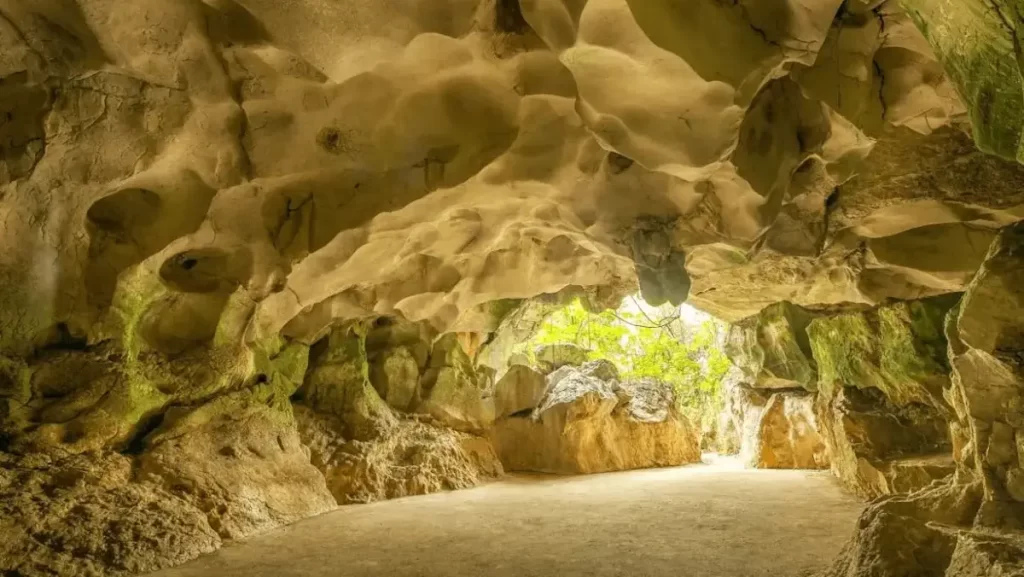
They are located in the El Pomier area, in the municipality of San Cristóbal, in the province of San Cristóbal, approximately 1 hour from the city of Santo Domingo. With an area of 4 km2. This set of Miocene caves has fifty-five caves divided into different rooms: the Great Edentates room, the Boinayel room, the Cohoba room and the Great Blocks room; each one characterized by some peculiarity and history that amazes the tourists who visit them.
The flora of the reserve is composed of 248 species of vascular plants, of which 207 are native and 22 are introduced. Only twelve species are endemic to Española Island. 31 species of birds have been reported, of which 4 are endemic. This protected area contains 54 caves, 30 of which have more than 4 thousand pictographs and petroglyphs belonging to at least two indigenous cultures, which are the Igneri and the Taíno. These caves are considered the prehistoric capital of the Dominican Republic.
The Pomier Caves have some places of cultural interest that are most used by tourists to visit and learn about their importance, these places are: Caves No. 1, 2, 3, 4, 5 and the Cueva del Puente. These caves are the most visited by tourists because they have pictographs and petroglyphs. Caves 1, 2 and 3 communicate with each other. Cave 1 is the best known for being the most visited since its existence was known. This cave contains more than 600 pictographs and petroglyphs. In 2018, the Pomier caves were included in the proposal “Pre-Hispanic Rock Art in the Dominican Republic”.
10. Iguabonita Cave

The Iguabonita Cave is located within the Scape Park in Cap Cana, near Punta Cana, in the Dominican Republic. This ecological park is one of the most popular destinations for those seeking an adventure and nature experience in the region.
The Iguabonita Cave is known for its impressive stalactite and stalagmite formations, as well as the vestiges of Taíno rock art that adorn its walls. These engravings and paintings, although not as abundant as in other caves in the country, are a reminder of the passage of the island’s ancient inhabitants.
The fascinating Iguabonita Cave Expedition begins with a walk along the slopes of the El Farallón cliff. Upon reaching the top, you will walk the little-explored trails through the lush jungle to discover some of its greatest natural treasures: medicinal plants, herbs and barks, which are still used today by the island’s healers. After a 25-minute walk, you will reach the mouth of the cave, where the underground adventure begins! Discover the vast network of chambers and tunnels with the support of expert guides, who will explain to you about the geological processes that, over thousands of years, gave rise to these impressive rock formations.
One of the outstanding features of the Iguabonita Cave is its easy access, as it is located within the Scape Park, which means that visitors can explore it safely with local guides. The tour of the cave usually includes a walk inside, where tourists can see the rock formations, enjoy the view and learn more about the geology and history of the island.
Tips for visiting
– Wear comfortable clothing: As you will be walking on rocky and wet terrain, it is advisable to wear suitable walking shoes and light clothing.
– Sun protection and repellent: Although the park has plenty of shade, it is important to bring sun protection, especially in open areas, and insect repellent.
– Local guides: Make sure to follow local guides during your tour, as they will not only accompany you to ensure your safety, but will also share interesting information about the history and ecology of the place.
The Iguabonita Cave at Scape Park is an excellent option for those who want to combine adventure, history and nature in one place. It is one of the most complete experiences to enjoy the natural beauty of the Punta Cana region.




